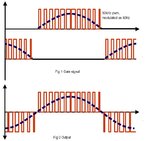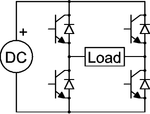samEEEf
Full Member level 2
Typically two stages are considered in SMPS inverter design so far I know which sees to be a good design.
Stage 1: Battery (DC) to high voltage DC. This is done using high frequency converter with a ferrite core transformer. Then LC filter
Stage 2: High volt DC to AC. This is actually the inverter where SPWM is used. Then LC filter.
Example: 12v DC----->400v DC----->230v AC (rms)
My question, what if I use only one stage? i.e, 12v dc to 230v AC (rms) just applying SPWM technique and a ferrite core transformer.
Stage 1: Battery (DC) to high voltage DC. This is done using high frequency converter with a ferrite core transformer. Then LC filter
Stage 2: High volt DC to AC. This is actually the inverter where SPWM is used. Then LC filter.
Example: 12v DC----->400v DC----->230v AC (rms)
My question, what if I use only one stage? i.e, 12v dc to 230v AC (rms) just applying SPWM technique and a ferrite core transformer.

